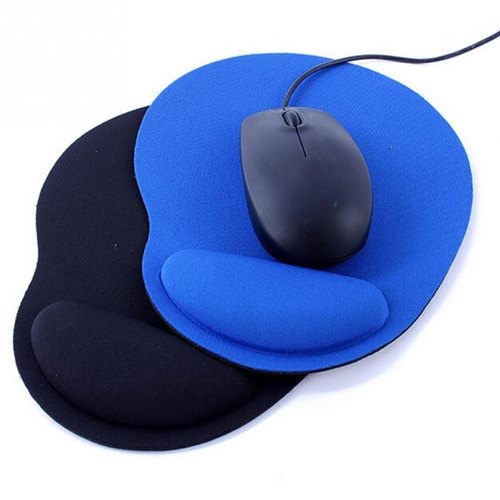
Mouse Pad The Ultimate Guide to Choosing the Perfect Mouse Pad
mouse pad is a surface for the mouse to glide on, designed to provide improved tracking, precision, and comfort during computer usage. The primary purpose of a mouse pad is to enhance the performance of the mouse, allowing it to register movements more accurately compared to using a bare surface. By providing a dedicated area for mouse movement, it reduces friction and can prolong the life of both the mouse and the surface it operates on. The importance of using an appropriate mouse pad becomes evident, particularly for gamers, graphic designers, and professionals who rely heavily on mouse precision.
The evolution of mouse pads has mirrored advances in technology and user requirements. Early mouse pads were simple, flat surfaces made from materials such as cloth or plastic. As mouse technology progressed, particularly with the introduction of optical and laser mice, the need for more specialized surfaces emerged. Contemporary mouse pads now come in various types, each tailored to specific user needs. Some of the common types include cloth mouse pads, which offer comfort and control; hard surface pads, designed for speed and precision; and ergonomic pads, which provide wrist support to alleviate strain during extended use.
Additionally, some mouse pads feature advanced designs, including RGB lighting for aesthetic appeal and functionality. The introduction of gaming mouse pads has also led to products engineered to enhance tracking for high-speed movements, catering to competitive gamers. As users become more cognizant of the impact a quality mouse pad can have, the range of available options continues to expand, emphasizing both performance and user comfort. Understanding the various types of mouse pads and their advantages is crucial for selecting the right one to meet individual needs and preferences.
Types of Mouse Pads
When selecting a mouse pad, understanding the various types available is crucial for enhancing your computing experience. Each type of mouse pad is designed to cater to specific needs, preferences, and activities, which can significantly impact performance and comfort during use.
The cloth mouse pad is the most common type, featuring a soft fabric surface that provides a balance of smoothness and control. This type is ideal for general use, as it accommodates a wide range of mouse sensors and is comfortable for long hours of work or gaming. The absorbent nature of cloth can also reduce friction between the mouse and the surface, leading to more precise movements.
In contrast, hard mouse pads, typically made of plastic or metal, offer a distinct feel. They create less drag, enabling faster mouse movements, making them suitable for gamers who require swift reflexes and precise aiming. However, these pads may be less comfortable during extended usage, as they lack the cushioning found in cloth options.
Gaming mouse pads stand out for their specially designed surface, which enhances tracking accuracy and responsiveness. These pads often feature larger dimensions to accommodate rapid movements required in competitive gaming. Some even come with additional features, such as RGB lighting, adding an aesthetic appeal to the gaming setup.
For those prioritizing ergonomics, ergonomic mouse pads are designed to provide wrist support, helping to reduce fatigue and strain during prolonged computer use. They often include a gel-filled wrist rest or contoured edges for a more natural position.
Lastly, custom mouse pads allow users to express their style or branding, featuring personalized images or designs. These pads cater to individual tastes while still providing functionality. By evaluating these various types, one can make an informed decision when choosing the perfect mouse pad for their specific needs.
Material Matters: Choosing the Right Surface
The choice of material for a mouse pad plays a vital role in enhancing the user experience and improving performance whether for gaming, graphic design, or general computer use. Mouse pads are commonly made from four principal materials: cloth, plastic, metal, and glass. Each surface has distinct characteristics that can influence mouse tracking precision, speed, and overall comfort.
Cloth mouse pads are popular due to their soft texture, offering a comfortable wrist experience during extended use. They often provide a balanced surface for both speed and control, allowing for smooth gliding while ensuring accurate tracking. The fibrous surface tends to absorb moisture and can therefore be beneficial in maintaining a consistent mouse response even when hands become perspired. However, cloth pads may require frequent cleaning, as dust and dirt can accumulate over time, impacting functionality.
Plastic mouse pads, in contrast, are designed for speed. Their slick surfaces allow the mouse to glide effortlessly, making them an excellent choice for fast-paced gaming environments where quick movements are crucial. However, these pads may lack the tactile feedback that some users prefer, making them less favorable for precision tasks like design work. Furthermore, their durability may vary depending on the quality of the plastic used.
Metal and glass surfaces offer a premium feel, typically providing excellent durability and stability. They are exceptionally easy to clean and maintain, ensuring a consistently smooth surface. While these materials often facilitate high-speed movements, they can be less forgiving in terms of mouse sensitivity adjustments. Metal pads may also contribute to noise due to their hard surfaces, which can be distracting in quieter environments.
Ultimately, the choice of mouse pad material should be guided by the user’s specific needs—whether comfort, speed, or precision is the priority. Taking the time to assess these factors will lead to a more satisfying and productive computing experience.
Size and Shape: Finding the Perfect Fit
The size and shape of a mouse pad play a crucial role in optimizing user experience, whether for general computing, graphic design, or gaming. Standard mouse pads are typically around 9×7 inches, accommodating basic needs for typical office setups. However, as gaming has evolved, so have the requirements for mouse pads. Gamers often benefit from larger mouse pads, commonly referred to as extended or gaming pads, that provide ample space for mouse movements. These pads can measure anywhere from 30 to 36 inches in length, allowing seamless movement and quick reflex actions in fast-paced environments.
The shape of a mouse pad also dictates its usability. While rectangular shapes are the most common, alternative forms such as circular or wrist-support pads have gained popularity. Circular mouse pads may cater to users who prefer a unique aesthetic, while ergonomic designs with built-in wrist supports address comfort and strain reduction during extended use. Understanding how these shapes fit within your workspace is essential for ensuring a comfortable and productive environment.
Additionally, the surface area of a mouse pad should be aligned with your specific usage pattern. For instance, users who perform precise movements, such as graphic designers or CAD professionals, might require smaller, textured pads that facilitate accuracy. Conversely, casual users or gamers who rely on swift and sweeping motions will likely benefit from larger pads that accommodate expansive gestures without limitation. This correlation between surface area and user habits illustrates the importance of thoughtfully selecting the right mouse pad to enhance overall functionality and comfort in workspace dynamics. Choosing the perfect size and shape aids not only in performance but also contributes to an aesthetically pleasing workstation.
Special Features and Add-ons
When selecting the ideal mouse pad, various special features and add-ons can significantly enhance the user experience. One notable category is wrist support. Many modern mouse pads come equipped with ergonomic wrist rests, designed to alleviate strain during extended computer sessions. These cushions are often made from memory foam or gel, providing a comfortable surface while ensuring the hand remains in a neutral position. This feature is particularly essential for professionals or gamers who spend long hours on their computers.
Another popular addition is RGB lighting. As aesthetics play a considerable role in gaming and personal workspaces, mouse pads featuring customizable RGB lights have surged in popularity. These pads often come with software that allows users to synchronize lighting effects with other RGB peripherals, thereby creating an engaging and cohesive setup. Beyond mere visual appeal, RGB lighting can add an element of personalization, allowing users to express their style or mood while working or gaming.
Furthermore, with the rise of wireless technology, some mouse pads now offer built-in wireless charging capabilities. This innovative feature allows users to charge their wireless mice simply by placing them on the pad, thereby eliminating the need for separate charging docks or cables. The convenience of integrated wireless charging not only streamlines the workspace but also ensures that the device is always ready for use.
Lastly, the inclusion of anti-slip bases is crucial for maintaining stability during intense gaming or work sessions. A mouse pad with a dedicated non-slip surface prevents unwanted movement, ensuring precise control and smooth operation. When opting for a mouse pad, it is worthwhile to consider these special features and add-ons, as they can greatly enhance overall functionality and contribute to an improved user experience.
Cleaning and Maintenance Tips
Maintaining your mouse pad is essential for optimal performance and longevity, regardless of its type, whether cloth, plastic, or hard surface. Each material requires a distinct care routine to preserve its functionality and appearance.
For cloth mouse pads, it is critical to address stains and dirt regularly. Start by removing any debris with a light vacuum or a lint roller. To clean deeper, use a mild detergent mixed with water. Dip a soft cloth or sponge into the solution and gently scrub the surface. Rinse the cloth pad with clean water to remove any soap residue and then lay it flat to dry. Avoid wringing out the material, as this process can damage the fibers. It is essential to ensure that the mouse pad is completely dry before placing it back on the desk.
Plastic mouse pads, on the other hand, are easier to clean and typically more resistant to moisture. Use a soft cloth dampened with mild soap and water for routine maintenance. For tougher stains or grime, an alcohol-based cleaner can be effective. Simply spray the cleaner on the surface, wipe it clean, and ensure it is thoroughly dried before use. This method helps maintain the smooth surface necessary for precise mouse movements.
Hard surface mouse pads, including glass or aluminum types, necessitate similar care as plastic. Using a soft cloth or microfiber towel can help avoid scratching while ensuring a clean finish. A quick buff with a glass cleaner can restore shine as needed but remember to keep the cleaner away from the mouse pad’s underside to prevent slippage during use.
Lastly, maintaining hygiene is of utmost importance, especially in environments such as offices or gaming setups where multiple users may interact with the same equipment. Regular cleaning not only ensures the longevity of your mouse pad but also promotes a healthier workspace by mitigating the buildup of dirt and germs.
Where to Buy: Retail and Online Options
When it comes to purchasing a mouse pad, consumers have numerous choices available through both retail locations and online platforms. Each option comes with its advantages and disadvantages depending on individual preferences and purchasing habits. Local retail stores, such as electronics shops and office supply outlets, allow customers to physically inspect mouse pads before making a purchase. This tactile experience is particularly beneficial for assessing the material, size, and design, which can significantly impact the user experience. Additionally, these stores often have knowledgeable staff who can provide recommendations based on personal needs.
On the other hand, online shopping has become a dominant force in the retail sector. Websites such as Amazon, Newegg, and dedicated gaming stores offer a vast array of mouse pads from various brands, catering to different styles and specifications. Shopping online often provides consumers with access to a wider selection, competitive pricing, and the convenience of home delivery. Moreover, online reviews and ratings can help buyers make informed decisions, as they can gauge the firsthand experiences of other users.
When considering where to buy a mouse pad, it’s essential to evaluate trusted brands such as SteelSeries, Razer, and Logitech, known for their quality and performance. Retailers like Best Buy and Micro Center are also reputable options for those preferring the in-store shopping experience. Ultimately, the choice between retail and online shopping depends on personal preference, urgency, and the availability of specific products. It can be advantageous to explore both avenues to determine which option aligns best with your needs and expectations.
Cost Considerations: Budget vs. Quality
When selecting a mouse pad, it is crucial to evaluate both budget constraints and quality. The market offers a diverse range of mouse pads at varying price points, typically categorized into low, mid-range, and high-end options. Low-cost mouse pads, usually priced below $10, tend to be made from basic materials with limited durability. While they may serve their purpose for casual users, they often lack essential features such as anti-slip bases or advanced surface textures that optimize mouse performance.
Mid-range mouse pads, often priced between $10 and $30, offer a more balanced option for users looking for quality without breaking the bank. At this level, consumers can expect better materials and enhanced durability, along with improved features such as thicker cushioning or fabric that enhances both speed and control during use. These products cater to users who might engage in gaming or work that demands a higher level of precision.
High-end mouse pads, which can cost upwards of $30, promise superior quality and features tailored to professional gamers and creative professionals. These mouse pads often incorporate advanced technologies like customizable RGB lighting and unique textile patterns to provide an exceptional tracking experience. While the initial investment may seem daunting, the longevity and enhanced performance can justify the cost over time.
Ultimately, the decision between budget and quality should be influenced by individual needs and usage patterns. Casual users may find that a basic model suffices, while gamers and professionals might benefit from investing in a high-quality option. Thoroughly assessing these factors can lead to a more informed purchasing decision, ensuring that the selected mouse pad effectively meets both performance expectations and budget requirements.
Conclusion and Final Thoughts
In navigating the realm of mouse pads, it is crucial to recognize how a seemingly simple accessory can have a significant impact on overall user experience. Throughout this guide, we have explored various factors that contribute to the selection of the ideal mouse pad, from material and size to texture and design. Each element plays a vital role in enhancing functionality, comfort, and aesthetics, tailored to an individual’s unique preferences and intended use.
The significance of compatibility cannot be overstated; choosing a mouse pad that harmonizes with one’s operational environment—be it a professional workspace, a gaming arena, or casual home use—can greatly enhance productivity and enjoyment. Users should consider aspects such as surface texture and optimal dimensions, which together, can accommodate different mouse specifications, including optical and laser designs.
Moreover, personal preferences should be at the forefront of any decision. Mouse pads available today range from ultra-smooth surfaces designed for fast-paced gaming, to textured options that offer precision and control. Experimentation is encouraged; many users may find that trialing different materials and sizes leads to a more personalized and effective setup. Ultimately, the goal is to discover a mouse pad that not only meets functional requirements but also resonates with one’s style and comfort levels.
As one immerses in the selection process, it is beneficial to remain open-minded. Feedback from fellow users, or firsthand testing could reveal hidden advantages of particular mouse pads. Prioritizing individual needs will inevitably lead to a more satisfying interaction with your mouse, enhancing both performance and overall satisfaction in the digital workspace. Embrace the customization of your setup, for the perfect mouse pad is a pivotal component of achieving excellence in both productivity and leisure activities.







